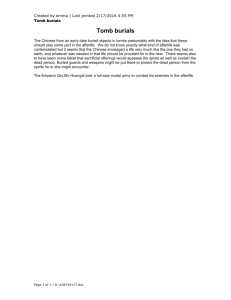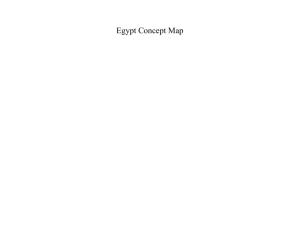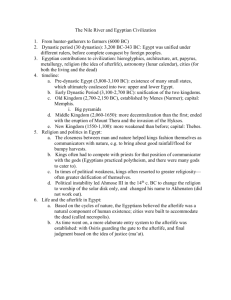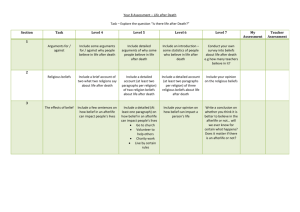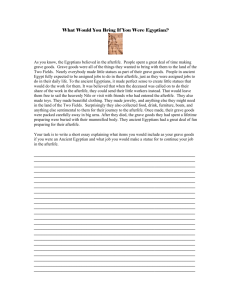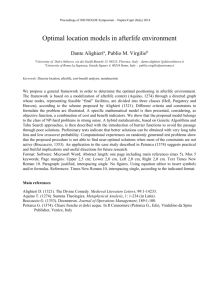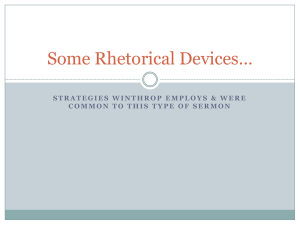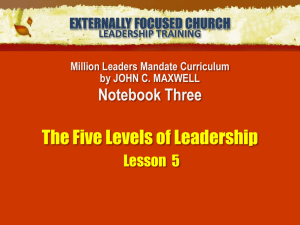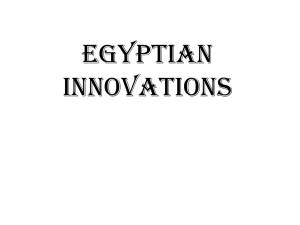Afterlife - Richard Elliott Friedman
advertisement
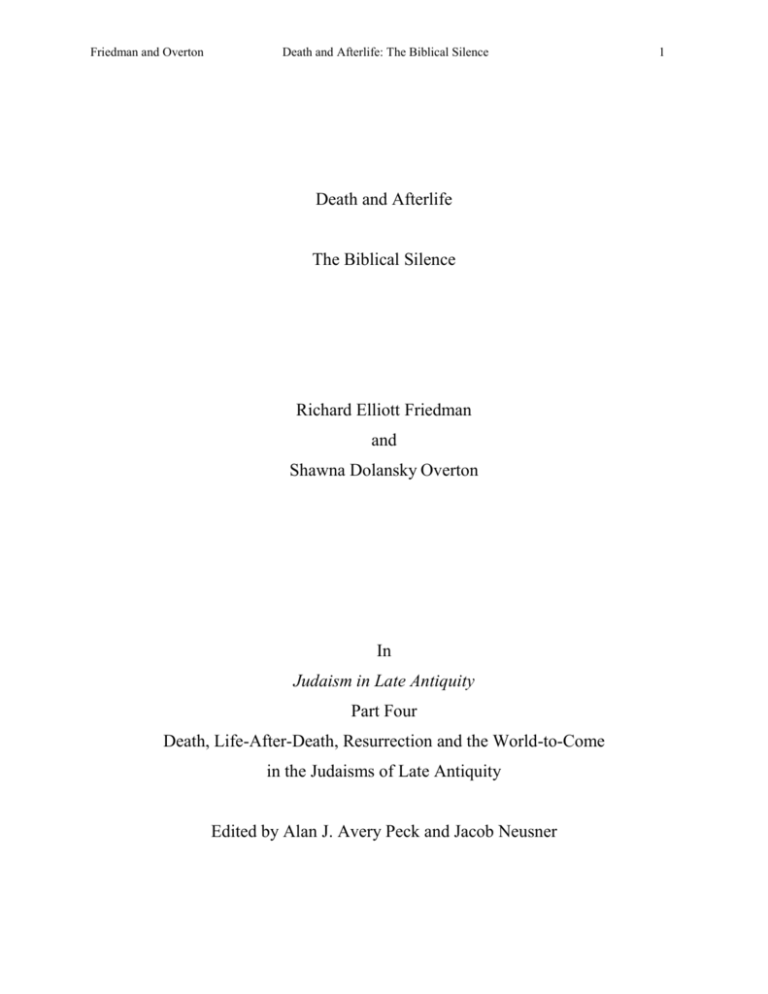
Friedman and Overton Death and Afterlife: The Biblical Silence Death and Afterlife The Biblical Silence Richard Elliott Friedman and Shawna Dolansky Overton In Judaism in Late Antiquity Part Four Death, Life-After-Death, Resurrection and the World-to-Come in the Judaisms of Late Antiquity Edited by Alan J. Avery Peck and Jacob Neusner 1 Friedman and Overton Death and Afterlife: The Biblical Silence 2 We have few unquestionable references to life after death in the Hebrew Bible. Our problem, though, is not only that we have so little to go on. The problem is also that this silence on such a common concern of religion is mysterious itself. We know that ancient Israel’s religion was monotheistic, though we may debate exactly when that monotheism began. We know that it had a hereditary priesthood, a link between religion and law, a concept of divinehuman covenant, and doctrines concerning patriarchs who migrated to the land from Mesopotamia and of slavery and exodus from Egypt. We know that it involved circumcision, animal sacrifice, forbidden and permitted animals, seasonal holidays, a sabbath, a Temple, opposition to idols, and the composition of sacred texts. Despite limitations of sources and the distance in time, we know a variety of facts, central and peripheral about the Israelites’ religion. Yet we have been uncertain about what they — from the person in the street to the High Priest — believed happens after death. Though belief in an afterlife was part of Mesopotamian religion to the east and is probably the most famous aspect of Egyptian religion to the west, it has been an enigma for Israel. The average Jewish or Christian layperson today has no idea what ancient Israelites believed; and scholars are uncertain, being dependent on relatively few passages from the text, which we have barely begun to study systematically. It is not as if death were an uncommon occurrence in ancient Israelites’ experience. Men’s average survival was only in the forties. Women’s was in the thirties. Women’s death in childbirth was almost fifty percent. Anyone who would reach middle age would have lost most of his or her immediate family. Death was so common, so familiar. Why, then, are there so few texts showing any interest in humans’ fate after dying? It would almost be better if there were no texts at all. Then we could conceive of a systematic rejection of such things by the biblical authors over the millennium that it took to compose the Hebrew Bible. There are, however, just enough suggestive texts to confuse the issue. So rather than biblical silence perhaps we should say that it is just a whisper. This whisper is faint enough to make people, especially non-specialists, imagine that there was Friedman and Overton Death and Afterlife: The Biblical Silence 3 virtually no belief in afterlife in constitutive biblical religion or in early biblical Israel thereafter. So, most recently, Neil Gilman, in a book on death in Judaism, asserts firmly and repeatedly that death was seen as final by the biblical writers, with no more than three possible exceptional passages in the entire Hebrew Bible. But we know that there was belief in an afterlife in Israel. The combination of the archaeological record and the references that we do have in the text leave little room for doubt. Archaeological data indicate the nature of such beliefs. J. W. Ribar (1973, 45-71) identified tomb installations that appear to reflect the existence of a cult of the dead and attendant beliefs that the deceased continued some form of existence after death. Ribar noted tombs that had apertures cut into their ceilings through which it would be possible to give offerings to the dead or which had storage jars placed directly over the heads of the corpses. Ribar’s examples include the Grabkammer II tomb from Megiddo (MB II B-C), Megiddo Tomb 234 (MB II), Hazor’s “porcupine Cave,” (MB II) and the caves in Area E, Gezer (late LB-Iron 1), the Double Tomb 67 from Tell Abu Hawam’s cemetery (LB II), Tombs I (Iron IIB) and II (Iron IIC) at BethShemesh, and one bench tomb from Sahab in Trans-Jordan (Iron IIC). Similar findings were made at a Late Bronze installation at Dothan. Although the Dothan material remains largely unpublished, R. E. Cooley (1983: 50-51) has reported concerning Tomb I (c. 1400-1200/1100): An auxiliary opening or circular window was positioned on the front side directly above one of the chamber niches. Outside the chamber and below the opening two large storage jars had been placed. Each jar contained a dipper juglet for the dead to receive the contents. . . Such provisions give sufficient evidence for the concern of the living to provide the dead with refreshing drinks. It is also possible that the Dothan installation was used for libations. . . At Dothan water would be poured into the chamber through the window opening and then the vessels placed along the stone retaining wall of the shaft. This would acount for the large number of Friedman and Overton Death and Afterlife: The Biblical Silence 4 vessels found outside the chamber. Few Palestinian sites have yielded such apparatus to supply water for the the thirst of the dead. The ritual purpose of these devices is clearly evident. Extensive excavations in Judah have produced an abundance of evidence surrounding Judahite burial practices, even more than have been recovered from northern Israel. Elizabeth Bloch-Smith’s detailed and comprehensive study is particularly valuable. To summarize: there were several different methods of interment, though the most common one for Iron Age Judah was the bench tomb. Despite much diversity in choice of specific goods provided for the deceased, all burials, bench-tomb or otherwise, contained the same categories of goods at comparable relative frequencies. Ceramic vessels and jewelry were most common, while personal items and tools were less so. Bloch-Smith explains that the abundance of ceramic vessels indicates that “nourishment in the afterlife was of paramount importance. An open vessel such as a bowl or crater for food, and a pilgrim flask, chalice or jar for liquids, were the most common forms, frequently accompanied in highland burials by a lamp for light” (141). Beginning in the tenth century BCE, bowls, storejars with dipper juglets, plates/platters, cooking pots, wine decanters and amphoras were widely adopted into the mortuary repertoire. Apparently, these new vessel forms functioned in the preparation, serving and storing of food and liquids. Numerous examples of food remains are further evidence of offerings to the dead (103-8). Additionally, Bloch-Smith cites the use of jewelry and amulets as evidence of the deceased’s need for protection via sympathetic magic (81-6). Recall also that the oldest known text of a portion of the Bible, an inscription of the Priestly Blessing from Num 6:24-26, was found inscribed in silver foil which was rolled and placed on a body in an Iron Age Judean tomb (Barkay, 1986). Bloch-Smith further suggests that the presence of female pillar figurines in many tombs is best explained as an appeal to sympathetic powers in which the dead were thought to intercede on behalf of surviving family members (94-100). Friedman and Overton Death and Afterlife: The Biblical Silence 5 Israel’s grave goods are similar to those of its neighbors whose afterlife beliefs are wellknown. Egypt’s cult of the dead is familiar through pyramids, mummification, and the Book of the Dead. Egyptians’ central concerns were with providing the proper provisions for the deceased, especially of royalty and nobility, so that they might live comfortably in the afterlife and bestow blessings upon the living. Mesopotamian literature also indicates a vibrant cult of ancestral veneration. Within each family, a “caretaker” (paqidu) was responsible for the care of the ghost (etemmu) of his deceased ancestor. This included performing such important services as making funerary offerings (kispa kasapu), pouring water (me naqu), and invoking the name (suma zakaru) (Bayliss 1973, 116). Necromancy was also a well-developed and intricate art. Magical literature mentions the restless ghost who returns to haunt the living, and works such as The Descent of Ishtar and The Epic of Gilgamesh demonstrate the belief in human afterlife in a world of dust. At Ugarit, too, there are comparable facilities for providing for the continuing wellbeing of the dead, and there are parallels with allusions to after-death experiences in the Bible. Excavations at Ras Shamra have revealed the use of pipes leading from ground level down into the tomb, which were used to provide the deceased with water (Lewis 1992a, 241). KTU 1.161 describes a liturgy of a mortuary ritual directed toward the deceased royal ancestors, some of whom are called rapi’uma (see our discussion of repa’îm below). The deceased are invoked to assist in bestowing blessings upon the reigning king. Other texts (KTU 1.6.6.45-49; 1.113) refer to the deceased as gods, ilu (see the discussion of ’elohîm below). Some scholars argue that the marzeah at Ugarit and elsewhere was “a feast for and with departed ancestors corresponding to the Mesopotamian kispu” (Pope, 1981: 176). The importance of ancestor worship is also seen in the phrase ’il ’ib, the “divine ancestor,” which occurs at the head of pantheon lists as well as in epic texts and sacrificial and offering lists (Lewis, 1989: 70). Especially important are recent studies that have advanced our understanding of ancestor veneration among the ancient Israelites as well. Albright began to make the case for ancestral sacrifices in 1957, when he suggested that this was one of the functions of the bamôt in ancient Friedman and Overton Death and Afterlife: The Biblical Silence 6 Israel. He concluded that “biblical references to veneration of heroic shrines (e. g. Rachel and Deborah), cult of departed spirits or divination with their aid, and high places in general add up to a much greater significance for popular Israelite belief in life after death and the cult of the dead than has hitherto appeared prudent to admit” (1957: 257). Since then, a number of scholars have pursued this line of inquiry. In particular, H. C. Brichto has gathered an abundance of evidence demonstrating the persistence of ancestor veneration in ancient Israel, focusing mainly on the importance of land ownership in connection with the continuation of a lineage. He stresses the prohibition against selling one’s land forever, stating that with land remaining the property of a family in perpetuity, it belongs “to the dead ancestors and to their unborn descendants — it is a sine qua non of their stake in immortality” (1973, 9). The dead were buried on their land, and their descendents were responsible for the maintenance of the grave. Similar to what we know of ancient Mesopotamian practices, Brichto claims that the condition of the dead in the afterlife is “connected with proper burial upon the ancestral land and with the continuation on that land of the dead’s proper progeny” (1973, 23). Bloch-Smith agrees, stating that “an ancestral tomb, whether located on inherited land or in the village cemetery, served as a physical, perpetual claim to the patrimony. Family proximity to the tomb facilitated caring for and venerating the dead. These functions of the tomb, in addition to the attributed powers of the deceased, made the cult of the dead an integral aspect of Israelite and Judahite society” (1992, 146). The powers of the dead to which Bloch-Smith is referring would include the ability to know the future as well as the ability to bestow blessings upon one’s descendants, assuming proper obeisance was made to the ancestors. Homage was paid through correct burial, maintenance and care of the grave, and offerings of food, libations, and incense to appease the dead spirits. Deut 26:14 explicitly disallows offering the dead tithed food; but, as many scholars have observed, this prohibition is not against making other offerings of food to the dead. Brichto points out that “not only does this verse attest to the practice, as late as the time of Deuteronomy, of offerings made to the dead; it attests that normative biblical religion accorded them the Friedman and Overton Death and Afterlife: The Biblical Silence 7 sanction of toleration” (1973, 29). T. J. Lewis concurs, pointing out that scholars for over a hundred years have suggested that this passage in Deuteronomy may allude to offerings to the spirits of the dead “for the purpose of rendering them propitious to the survivors” (see Driver, 1916, 291-292, whom Lewis cites, though note Driver’s reservations; Lewis 1989, 103). Baruch Halpern has identified the historical context within which ancestor veneration thrived for centuries and then was forcibly diminished as an increasingly radical monotheistic urban elite gained ascendancy in Judah under Kings Hezekiah and Josiah. Prior to the devastation of the Judean countryside by the Assyrian emperor Sennacherib during the time of Hezekiah, the bulk of the population lived in the rural areas outside Jerusalem and maintained traditional clan and kinship-based communities, largely removed from political influences within Jerusalem. “Along with blood claims and claims on the land, the clan sector (mispahâ) shared its ancestry. Indeed, ancestry and the common treatment of the ancestors were a language in which claims to property could reliably be lodged.” The orientation of each individual kinship community was inward as members of each community shared ancestry and property, and this common heritage formed the basis for such annual ancestral sacrifices as described in 1 Sam 20:6, where this event is David’s pretext for taking leave of Saul. Burial customs reflected this, as Israelite rock-cut tombs prior to the seventh century were multi-chambered, with room for at least four generations of male offspring. Halpern emphasizes the pre-reformation state of Judah’s intra-clan sense of community and continuity with the statement that “the Israelite inherited the house of his ancestors, the fields of his ancestors, the tools of his ancestors, the gods of his ancestors, and, in the end, the place of his ancestors in the tomb” (Halpern, 1991: 57-59). Halpern’s work is a powerful merging of the archaeological evidence and the textual evidence to capture the place of ancestor veneration in ancient Israel. There is further internal evidence from the biblical text that coincides with the broader external picture from archaeology regarding the afterlife. First, there is a bank of terminology, some of it obvious, some of it not so obvious. The term that occurs most often in connection with after-death existence is Sheol (se’ôl). It appears sixty-five times in the Hebrew Bible. The book of Job refers to it many times, Friedman and Overton Death and Afterlife: The Biblical Silence 8 as do the narrative books, Psalms, Proverbs, and some of the prophets. Although most scholars think that it is a name for the netherworld, it is still an enigmatic term in that its original meaning and etymology are in dispute. It is not found in any of the cognate languages. Many suggestions have been made regarding the origin of this word, ranging from a speculative Akkadian su’alu, meaning “underworld,” which most agree is a misanalysis of the Akkadian, to a theoretical proto-Hebrew se’ô (root: s’h), which could best be translated as “nothingness” (Lewis, 1992b: 102). Stronger conjectures have been made by Albright, who first suggested Akkadian origins in the word sa’alu, making Sheol a “place of decision (of fates)” and later settled on a new analysis of Sheol as a place of ordeal or examination, arising out of Hebrew s’l, “to ask,” in the context of inquiry referring to the practice of necromancy (1918: 209-10). Oppenheim compares the roles of the sa’iltu-priestess in Akkadian (1956: 179-373). McCarter’s analysis of the river ordeal in ancient Israel led him to speculate that Sheol might originally have meant “the place of interrogation” (1973: 403-412). Another important term is repa’îm, which occurs infrequently but seems to denote denizens of the netherworld in Isa 14:9; 26:14 and Ps 88:11 In other places in the Bible we have references to the Valley of the repa’îm (Jos 15:8; 18:6; 2 Sam 5:18, 22; 23:13) and to the repa’îm as one of the indigenous peoples of Canaan (Gen 14:5, Deut 2:11,20; Deut 3:13), but in the Isaiah passages and Psalm 88 the repa’îm are the dead, continuing some sort of existence in an underworld (see also Pro 2:18; 9:18; 21:16; Job 26:5). Given this confusing assortment of meanings for the word, it is fortunate that fifth century Phoenician inscriptions attest to the repa’îm as those whom the living join in dying (KAI 13:7-8, 14:8). As we have seen, it is also found in Ugaritic (KTU 1.61), connoting a line of dead kings and heroes (cf. Isa 14:9). Alan Cooper (1987: 3-4) traces the etymology of repa’îm to Ugaritic Rp’u, a chthonic deity and patron god of the King of Ugarit, associated with healing in the sense of granting health, strength, fertility, and fecundity; hence the Hebrew rapa’, “to heal.” This is important in discussing ancestor veneration in the ancient Near East, as the purposes for revering one’s dead ancestors were often requests for health, strength, and progeny. Friedman and Overton Death and Afterlife: The Biblical Silence 9 The term terapîm is another relevant one, appearing in a number of passages in the context of divination. The etymology of terapîm points to an origin in Hittite tarpis, “spirit” (Hoffner, 1968: 61-68). On the basis of Mesopotamian evidence, K. vander Toorn interprets the terapîm as ancestor figurines which would have been used both at home and in the public cult for divination (1990: 211). According to C. Kennedy, the terapîm were ancestral images that could be life-size, as in 1 Sam 19:13, or as small as a mask; and he notes that the Septuagint translates terapîm in the case of Rachel’s theft from her family in Gen 19:31 as eidolon, i. e. an image of the dead (Kennedy 1992: 106). In 2 Kgs 23:24 they are listed as one of the divinatory and idolatrous items destroyed by Josiah in the course of his reform. Ezekiel envisions the king of Babylon consulting them in tandem with the employment of divination by casting arrows (belomancy) and by reading livers of sacrificed animals (hepatoscopy) in order to obtain an oracle (21:26), and Zechariah has the terapîm speaking in parallel to the diviners who relate false visions (10:2). Brichto employs this idea of the terapîm as ancestral figurines to support his controversial view of another term, stating that “the physical representations of the household gods. . . are universally presumed to be designated by the Hebrew word terapîm. If this presumption is correct, these representations may be present elsewhere masked under the more general term ’elohîm, ‘gods,’ as they are clearly designated in Gen 31:30, where Laban uses the expression ‘my gods’ for the teraphim filched by Rachel” (Brichto 1973: 46). Brichto and others (Bloch-Smith 1992: 122-123; Lewis 1989: 175; Vander Toorn 1990: 210-11) have put forth the disputed notion that sometimes when the word ’elohîm appears in the Bible it is referring to the spirits of dead ancestors rather than to God. Their best example of this is in 1 Sam 28:13, where the word ’elohîm is taken by some to refer to the ghost of Samuel. It has been suggested that Isa 8:19-21 also appears to be using the term ’elohîm in this way. Bloch-Smith takes this further and postulates that the terms ’elohîm and ’elohê ’abîw often mean “divine ancestors” rather than “God” or “god of his father,” and infers from this that passages such as Gen 28:22; 31:52-54; and Friedman and Overton Death and Afterlife: The Biblical Silence 10 46:1 are actually describing an oath sworn on deceased ancestors and sacrifices being made to ancestral deities (1992; 123). Lewis observes that Ps 106:28 contains the curious expression ‘sacrifices of the dead’ (zibhê metîm). It is proposed above that the traditional explanation of this phrase as referring to ‘dead idols’ is inadequate. Num 25:2 served as a source for the psalmist who consciously picked up on the phrase zibhê ’elohêhen with his wording zibhê metîm. It is the view of the present work that the key to understanding zibhê metîm lies in recognizing the parallel between ’elohîm and metîm. These two terms, which occur in parallel elsewhere in Ugaritic and Hebrew, can designate the spirits of the dead. (1989, 175) In the cases considered here, it is possible that ’elohîm was meant to designate spirits of the departed, though, in most occurrences of the word, ’elohîm certainly should be understood to mean “God.” The word ’ittîm appears only once in the Bible, in a passage in Isaiah (19:3), who seems to have a large vocabulary of words that refer to after-life experience. According to Tzvi Abusch, ’ittîm is cognate with Akkadian etemmu: ghost, shade, or spirit (1995: 588) — which is consistent with the context in Isaiah, which mentions the consultation of ’obôt and yidde‘onîm as well as of ’ittîm. In several places in which wizards, sorcerers, and other practitioners of forbidden magic are mentioned, we also find the phrase ’ôb weyidde‘onî(m) (Deut 18:11; 1 Sam 28; 2 Kgs 23:24; Isa 8:19). Although the precise meaning of each term is uncertain, the phrase is almost always understood as “necromancer” or “medium.” The term ’ôb is particularly ambiguous because it is found in a variety of contexts in which it can be understood as “spirit, ancestral spirit, the person controlled by a spirit, a bag of skin, the pit from which spirits are called up, a ghost, or a demon” (Kuemmerlin-McLean 1992: 469). It has also been suggested that its etymology should be Friedman and Overton Death and Afterlife: The Biblical Silence 11 sought in the Ugaritic phrase il ’ib, usually understood as cognate to Hebrew ’elohê ’abîw but plausibly meaning “god of the pit” rather than “god of the father(s)” (William Propp, personal communication). Although ’ôb is often found on its own (usually when it means “pit” or “bag of skin”), the word yidde‘onî(m) occurs only in tandem with ’ôb. Some scholars take the phrase as a hendiadys while others, along with most translations, see it as referring to separate persons (e. g. medium and wizard) (Kuemmerlin-McLean 1992: 469). The root seems to be yd‘, but what remains unclear is whether the “one who knows” is the spirit being consulted or the necromancer who does the consulting. This phrase is also frequently translated as “one who has a familiar spirit.” No matter how these words are translated, each translation conveys the basic idea of communication between the living and the dead. The term marzeah, referring to a sort of funerary society, cognate to the Ugaritic mrzh (see above), occurs twice in the Hebrew Bible (Jer 16:5; Amos 6:7; see Halpern, 1979: 121-140; Friedman, 1980: 187-206 for discussion and bibliography). Additionally, there are terms that usually do not refer to afterlife but which do have such meaning in particular, specialized contexts. Alan Cooper’s treatment of the word ‘ôlam in Psalm 24 is an important example of such a case. Cooper argues convincingly that Ps 24:7-10 is a fragment of a descent myth “in which a high god, forsaking his ordinary domain, descends to the netherworld, where he must confront the demonic forces of the infernal realm” (1983: 43). He sees two possible interpretations: (1) God’s entry into the netherworld to combat Death; and (2) God’s victorious emergence from the netherworld after subduing Death. One of Cooper’s main arguments is that the pithê ôlam are the same as the Egyptian gates of the netherworld. He lists other mentions of the gates of the netherworld in the Hebrew Bible: Isa 38:10; Jonah 2:7; Ps 9:14; 107:18; Job 38:16-17 (1983: 48n.). Beyond the collection of terms such as these, there are the cases in which afterlife is explicitly expressed. The late book of Daniel speaks of those who sleep in the dust who will wake (12:2). Centuries earlier, Isaiah speaks of the dead awaking and living, using similar language to that of Daniel, as well as referring to the repa’îm (Isa 26:19). And a century earlier Friedman and Overton Death and Afterlife: The Biblical Silence 12 than that, 1 Samuel 28 recounts the story of the woman of En-Dor raising Samuel, who complains about being disturbed, criticizes Saul (as usual), and tells the future (Saul’s demise). (On the date of the work to which the En-Dor story belongs, see below.) The terms and explicit references to afterlife occur early and late, in poetry and prose, distributed through the course of the Hebrew Bible. While arguments from silence must be taken with the usual cautions, we should still note also that the Bible has no criticism of any pagan society for belief in afterlife. Its attack on their icons is so common as to be well known to any Sunday school child. Its attacks on their sexual practices and on their human sacrifices (right or wrong) are numerous in the texts as well. But the closest it comes to polemic about the afterlife is to say that in a particular instance the Egyptians will turn to such sources for help but that this will not help them. Biblical law forbids Israelites from consulting a medium, but that is not a denial of the efficacy of what a medium does nor a criticism of the pagans for doing it. Similarly, the Torah forbids Israelites to practice magic, but it still depicts Egyptian magicians as able to turn sticks to snakes and water to blood. Indeed, all of the usual cautions apply, of course. The passages in Isaiah and Daniel are poetry. Sheol might just mean the grave, or generically and indefinitely the place where one lies when one dies, without meaning that one has consciousness there. And Samuel in the En-Dor episode, likewise, may simply be understood to be disturbed from eternal unconscious rest rather than from a place where persons are conscious after death. We may take the narrowest view possible of each case and term, but the nature and quantity of them is still too much to write off as a mass of uncertain instances. And, when taken with awareness of the historical and archaeological record, they add up to evidence of belief in an afterlife. (Thus Gilman’s insistence that biblical Israel knew no afterlife is based on such a taking of the narrowest view in every case that he considers and then holding that view to be determinative. Where he treats three cases of explicit reference to afterlife, he says: But that is only three cases — and the text in Daniel is late. And he does not deal with all of the applicable terms. And he does not deal with the archaeological evidence.) Friedman and Overton Death and Afterlife: The Biblical Silence 13 Both in the ground and on the parchment, we have reason to recognize that there were beliefs in life after death in biblical Israel. The question, then, is how to reconcile the biblical whispers with the evidence. How do we reconcile our knowledge that Israelites believed in an afterlife with the relative rarity of textual references? This requires an examination of authorship. One of the by-products of recent research by one of the authors of this article is some new data that may contribute to the solution of the present question. This research indicates that there is a continuous work of literature that is embedded among the narrative books of the Hebrew Bible. Its beginning is in Genesis, and it ends in 1 Kings 2. In the Torah it includes all of the text that has been known for over a century as J. J flows beyond the Torah, taking up portions of the books of Joshua, Judges, 1 and 2 Samuel, and the first two chapters of 1 Kings. It is thus the first lengthy work of prose known on earth. It tells a continuous story with hardly a single gap between the Torah and Kings, and it was composed by a single author, probably in the ninth century BCE.1 Now, the relevance of this to the matter of afterlife is that part of the evidence for identifying this work as a unity is the fact that certain terms and themes occur disproportionately in this work — or only in this work and nowhere else in biblical prose. Among the bank of such characteristic terms, we find that of the nine references to Sheol in all the prose of the Hebrew Bible, all nine are in this group of texts, and none in the rest of biblical prose (Gen 37:35; 42:38; 44:29; 44:31; Num 16:30, 33; 2 Sam 22:6; 1 Kgs 2:6,9). Of twelve references to teraphim, eight are in this group of texts, and four in all of the rest of biblical prose. 1 This was developed in an unpublished paper: Richard Elliott Friedman, “The First Great Writer,” which was read at the Biblical Colloquium and in colloquia at Cambridge; Yale; The Hebrew University of Jerusalem; the University of California, Berkeley; and the University of California, San Diego. It now appears in R.E. Friedman, The Hidden Book in the Bible (San Francisco, HarperCollins, 1998). Friedman and Overton Death and Afterlife: The Biblical Silence 14 It is not just a matter of the terminology employed. The author of this work uses imagery that none of the other biblical prose authors use. In the episode of the rebellion against Moses and Aaron in Numbers 16, this author’s story of Dathan and Abiram has been combined by an editor with the parallel story of Korah from P, but the two stories have notably different endings. In the P Korah account, Korah’s followers are burned; but in the J account (16:30-34) Dathan and Abiram along with their families and possessions are swallowed up by the ground and go down to Sheol alive. It is also in this author’s narrative that the story of the medium at En-Dor communicating with the deceased Samuel occurs. It is also in this work that the story of Israel’s heresy at Baal Peor occurs (Num 25:1-5), involving the possible case of “sacrifices of the dead,” (zibhê metîm/zibhê ’elohêhen ), as discussed above. And many times in this work there are reports of a man being buried in his father’s tomb: Gideon (Judg 8:32), Samson (16:31), Asahel (2 Sam 3:32), Ahitophel (17:23 ), and Saul and Jonathan (21:14). The words “He was buried in his father’s tomb” do not occur anywhere else in the Hebrew Bible. And it is also this work that notes in the account of Moses’ death that “no man knows his burial place to this day” (Deut 34:6). The fact that this author is concerned with the location of the grave is notable because ancestor veneration is crucially linked with the actual grave site. As Halpern has shown, the forced separation of the people from these sites in Hezekiah’s reign was a turning-point in the triumph of Israelite monotheism and centralization of worship. This report that no one knows Moses’ burial place has been taken to “emphasize the very finality of the death of this man,” (Gilman: 64 ), but it is a stretch to imagine an author choosing to raise this fact in order to convey that message. In a world in which ancestor veneration is practiced, we would more readily expect this report to mean just the opposite, emphasizing that the non-knowledge of the burial place is a striking fact because ancestor veneration must be linked to a burial place. And all of the other reports about burials in the family tomb in this work support the likelihood that this is the author’s concern. Now, none of the other sources of the Torah has any of this terminology or this imagery. What is the difference between this author and the authors of all of the rest of the Torah? The Friedman and Overton Death and Afterlife: The Biblical Silence 15 most prominent distinction that comes to mind is that this author is a layperson while all of the others are priests (Friedman, 1987: 72-74, 79, 83, 85-86, 120-124, 128, 188, 210-211, 214). The authors who are priests do not discuss conceptions of the afterlife except in the context of prohibitions. Restrictions against contact with the dead and involvement in certain mortuary practices can be found in both the Deuteronomistic legal material and the Holiness Code: Deut 18:10-11 and Lev 19:31; 20:6; 20:27 prohibit the consultation of dead ancestors either directly or through necromancers and other intermediaries. Deut 26:14 forbids feeding the dead tithed food, and Deut 14:1 and Lev 19:27-28; 21:5 all object to engaging in the self-laceration rituals employed in Canaanite death cult practices. Lewis observed that “priestly material seems almost preoccupied with the defiling nature of the corpse, the bones, and the grave. This preoccupation stands out in contrast to the surrounding cultures of the ancient Near East and may indeed be a reflection of an attempt to combat a cult of the dead” (1989, 175). But, again, this does not necessarily deny that such mechanisms of communicating with the dead are effective. Brichto, too, notes that “the prohibition of recourse to the dead for oracles is in no way a denial of their existence in an afterlife, of their accessibility to the living and of their interest in them” (1973: 8). This is why it would have been in the priests’ interest to suppress the proliferation and undermine the legitimacy of cults of the dead. These cults were not limited to the employment of necromancers. Indeed, specialists were not needed at all to propitiate the good will of the deceased and accrue blessings. The best way for an ancient Israelite to ensure health, prosperity, and fertility was to propitiate the family’s dead ancestors. This did not require a priest, it brought no income to the priesthood, and it could even compete with priests’ income and authority. The authors of the Priestly portions of the Torah (P) promoted precisely the opposite idea: the only legitimate avenue to the deity is the priests. In the Priestly work there are no angels, no dreams, no talking animals. There are not even prophets. The very word “prophet” occurs only once, and there it refers figuratively to the High Priest, Aaron (Exod 7:1). There are no accounts of sacrifices prior to the inauguration of Aaron as High Priest. And no formal Friedman and Overton Death and Afterlife: The Biblical Silence 16 worship is permitted outside of the Tabernacle — which means the Temple, either really or symbolically. There is no description of the creation of any realm of the dead in the Priestly creation account in Genesis 1. (There is none in the J account in Genesis 2 either, but that account does not pretend to be a picture of all of creation in the way Genesis 1 is; thus it also does not include the creation of the heavenly bodies or the seas.) For P there is one God, one Temple, one altar, one sanctioned priesthood. When the Priestly narrative deals with a family tomb — specifically, in the case of the cave of Machpelah — the focus is explicitly on the purchase of the cave and the land surrounding it, both in the original story (Genesis 23), where the transaction is described in detail and the purchase price is specified, and in every mention of the cave thereafter (Gen 49:29-33; 50:12-13). Rather than relating to ancestor veneration, this focus serves the function of establishing the legitimacy of Israel’s ownership of Hebron, the locale of the cave, which was a city assigned to the Aaronid priests, the group who produced the Priestly narrative (Josh 21:811). Though most of the field of biblical scholarship continues to date the Priestly texts to the post-exilic period, the weight of the current evidence, particularly the linguistic evidence, points to the time of the First Temple (Friedman, 1987: 161-216; 1992: 605-622). The Hezekian dating of these texts naturally connects them with the centralization of the Israelite religion that is ascribed to that king’s reign. It also corresponds to Halpern’s historical description of the religious and political change that followed the destruction of the northern kingdom of Israel and Sennacherib’s campaign against the southern kingdom of Judah. The devastation of the countryside made possible the idea of centralizing the priestly authority in Jerusalem. This was precisely the era of the end of the local ancestral veneration sites. But ancestor veneration must be on the site (so Brichto, Halpern, and Bloch-Smith). A combination of Sennacherib’s campaign and Hezekiah’s political ingenuity put an end to this traditional community in rural Judah. According to Halpern, in order for Hezekiah to justify sacrificing the outlying communities’ lands to Sennacherib’s armies he had to desacralize Friedman and Overton Death and Afterlife: The Biblical Silence 17 the land itself by discrediting traditional ancestral worship; this in turn allowed him to accomplish the centralization of worship in Jerusalem (Halpern 1991: 26-7, 73-76). “For Hezekiah’s purposes, it had been essential to amputate the ancestors, those responsible for the bestowal of rural property to their descendants: they, and they alone, consecrated the possession of land” (74). Without their traditional ancestral lands, the people’s ties and sense of community were of necessity transferred to the monarchy, and competition between ancestor veneration and centralized worship at the Temple in Jerusalem was eliminated. This understanding is corroborated by the advent of a new type of burial, in which individuals, married couples, and occasionally nuclear families were buried in a communal necropolis rather than in family crypts (73). The Priestly (P) narrative and laws thus reflect this stage in the history of the religion of Israel, when a centralized priesthood displaced local worship that had included ancestor intercession. The sources of the Torah known as E and D reflect the same concerns as P. Their authors appear to come from a different priestly house, identified in some recent scholarship as Shilonite or Mushite (Cross, 1973), but their interests on this point are the same. They were probably against local ancestor veneration from the beginning — as reflected in E, which is from the time of the divided monarchy (pre-722 BCE), and in the oldest portions of the Deuteronomic law code (which may be even older than E) — because it was performed at home, with no need of an altar or a priest as intermediary. They were certainly against it from the time of King Josiah, whose religious reform was even more radically centralizing than Hezekiah’s had been. The Shilonite/Mushite priesthood came to power with Josiah, and D is traced to that period. As Halpern has characterized Josiah’s reform: “It was a systematic effort to erase from the nation’s history the memory not just of a royal predecessor but of a whole culture” (1996: 329). By the time of Josiah, this centralizing tendency had heightened as the state religious practice became the moral norm, and the assault on kinship grew more radical, particularly because Manasseh’s intervening reign had allowed the re-establishment of many of the traditional high places and centers for non-Jerusalem religious activity (Halpern 1991: 74). By the time of Josiah, no such Friedman and Overton Death and Afterlife: The Biblical Silence 18 activity was tolerated outside the Temple; as Halpern states, “the state, now, acted as a surrogate for the old tribal institutions, while professing all the while the ideology of those institutions” (76). Thus E and D also avoid the issue of life after death, except to prohibit contact with the dead in several passages of Deuteronomy. Like P, they are by priests; and, like P, they are silent on life after death. When we move on from the Torah to the histories, the situation is the same. The full Deuteronomistic history, which extends from Deuteronomy through 2 Kings, comes from the same hands as Deuteronomy itself, and those are the hands of priests, the Mushite or Shilonite priests who rose with Josiah. And the Deuteronomistic historian is silent on afterlife. Where the history includes anything to do with this subject, it is found in a passage that is manifestly from one of the historian’s sources, not from the historian himself. The story of the medium at EnDor, for example, belongs to the source work that we described above. It does not contain any of the characteristic language of the Deuteronomistic historian himself. Similarly, there are the three resuscitation stories in the books of Kings. Elijah and Elisha each participate in bringing a dead boy back to life (1 Kings 17, 2 Kings 4), and a chance contact with Elisha’s bones revives a dead man on his way to burial (2 Kings 13). One may say that these stories do not necessarily imply the existence of any realm of conscious afterlife in any case; but, even if we take the view that they do imply some such realm of post-mortem existence, they, too, contain no characteristic Deuteronomistic language. They rather belong to one of the Deuteronomist’s sources, a chronicle of the northern kingdom of Israel. The same applies to the story of Elijah’s ascent in a whirlwind in 2 Kings 2. The story is often taken to mean that Elijah does not die. Alternatively, it may be precisely the account of his death. Either way, though, it belongs to the source, not to the historian’s own composition. One may ask why the Deuteronomistic historian retained these stories if they presented things in which he did not believe. The long answer would involve a proper analysis of how each of the biblical editors and historians worked and what their respective attitudes were toward Friedman and Overton Death and Afterlife: The Biblical Silence 19 their sources. The brief answer for our present purposes is that the Deuteronomistic historian included lengthy source texts without apparently feeling the need to make constant interruptions and cuts, so long as he could compose the introduction, framework, and conclusion to set the history in his particular perspective (Friedman, 1987: 130-145; 1995: 70-80). The other major historical narrative, the Chronicler’s Work, comprising the books of Chronicles, Ezra, and Nehemiah, is commonly associated with the same priestly community that produced the Priestly Work (P), i. e. the Aaronid priesthood. It should come as no surprise that the Chronicler’s Work, like other priestly products, does not deal with afterlife. This same distinction between lay and priestly writers prevails in the Major Prophets. Jeremiah and Ezekiel are priests. Jeremiah is associated with the priestly house that produced the Deuteronomistic texts; Ezekiel is associated with the Aaronid priestly house that produced the P texts. Neither of them is known for afterlife terminology. The book of Jeremiah in particular does not include occurrences of terminology associated with post-mortem existence. Ezekiel has the famous dry bones that become animated, but it is not at all clear that this points to any Jewish belief in afterlife in that period. In the first place, it is just a metaphor within a vision, used to express the possibility of regeneration of Israel after a national catastrophe. Second, it refers to resurrection, not to the existence of a post-mortem realm. Third, and above all, it may just as likely be evidence against belief in afterlife as for it. One could argue that it shows that Jews believed in such things, or one could just as easily argue that it is presented as something extraordinary and unanticipated, something that was not commonly believed. Meanwhile, the prophecy of (First) Isaiah, who is not a priest, is filled with allusions to afterlife experience, employing such terms as se’ôl, repa’îm, and ’ittîm. This is surprising in that Isaiah is presented as a supporter of Hezekiah, the king in whose reign the centralization of religion triumphed and the Aaronid priesthood achieved ascendancy over other priestly houses and the sites of ancestor veneration were wiped out. It may be, nonetheless, that the prophet could consistently both support all of the royal ideology and still speak of afterlife as a Friedman and Overton Death and Afterlife: The Biblical Silence 20 phenomenon. As a layperson he would not necessarily have the same stake as a priest in actively suppressing any talk of afterlife in his writings. Why would priests in general be so averse to discussing anything regarding after-death experience, while someone like the author of J incorporates it as though taking for granted that it was part of his or her readers’ world view? First, as we discussed above, local ceremonies for dead ancestors did not require a priest, brought no income to the priesthood, and could even compete with priests’ income and authority. The priests’ livelihood was dependent on sacrifices to YHWH, and the priestly laws were designed in such a way as to ensure that all aspects of interaction with the divine were conducted only through the priests. If a belief in an afterlife was encouraged, and necromancy was given legitimacy as a means for knowing the divine will, then the priests would be ceding a portion of the control of the religion. In this vein it is important to note that in the story of the woman of En-Dor, Saul is seeking a necromancer precisely because “Saul saw the Philistines’ camp and was afraid, and his heart trembled very much. And Saul asked of YHWH, and YHWH did not answer him, neither through dreams nor through Urim nor through prophets” (1 Sam 28:5-6). Thus, although he has banished all necromancers from the land in accord with the law, in order to learn his fate Saul must turn to one of them for answers; and she is able to conjure up Samuel. Thus, through the necromancer, Saul succeeds in circumventing YHWH’s silence. The dead Samuel has access to knowledge regarding the will of YHWH and is able to predict Saul’s future for him. The inherent lesson in this is that one need not go through priests and legitimate means of inquiry regarding the divine will so long as one has recourse to inquiring of the spirits of the deceased. Since the priests were not necromancers, this was not an aspect of religion that they could control. It is thus natural that they not grant it legitimacy by even hinting at the existence of an underworld or an afterlife in their writings despite the fact that such beliefs may have been popular and widespread. A second explanation of the priesthood’s opposition to afterlife beliefs is related to the hypothesis that the priestly group, the Levites, originally came from outside the land. On this Friedman and Overton Death and Afterlife: The Biblical Silence 21 hypothesis, the Levites were the Israelites who had experienced the enslavement and exodus and who then entered Israel and merged with the tribes who already resided there. They therefore did not have ancestral territory, which is essential to local veneration practices. (That is why the Levites receive ten percent of the other tribes’ produce; it is in lieu of land.) Their ancestors were presumably buried back in Egypt. Even if they had originated in Canaan prior to their sojourn in Egypt, they were long cut off from the burial sites of their ancestors. A third possibility is that perhaps the laws forbidding contact with the dead for priests were in place before necromancy and such things were popular or before the Levitical priests came into contact with this type of religion, and so priests could not have anything to do with those practices. Another possibility is that the Levites, coming from the Egyptian experience, were reacting against Egyptian religion’s obsession with the dead. To find the origin of an antipathy to such beliefs and practices, we might be best advised: Go back to Egypt — and to the founder. If a historical Moses really was offended by all of that concentration on death, he might well have bequeathed to his followers and successors a strict rejection of the entire scheme. These possibilities are all speculative, and we raise them only to establish that there are in fact historical scenarios in which we can conceive of a priesthood which is at odds with the masses regarding afterlife. And we know of the historical scenario in which the religion of Israel was centralized — first in the reign of Hezekiah and then more thoroughly in the reign of Josiah — which would have made it possible for the priests’ view to predominate over the popular view. We therefore advise caution against taking what appears to be a thin distribution of references to afterlife as evidence that there was little belief in it. Similarly, we caution against scholarly models of linear progressions, seeing Israel as moving from periods of belief to complete rejection (Job 14:12-14; Eccl 9:5-10) to a final full-blown belief (Dan 12:2 — “those who sleep in the dust will wake. . .”) (Spronk 1986; Lang 1988; Pitard 1993). The problem with both of these positions is that they do not take sufficient account of the specific background and Friedman and Overton Death and Afterlife: The Biblical Silence situation of each of the biblical authors. layperson or priest. 22 It makes a difference whether the author was a And the historical events that led to religious centralization made a difference in who had the opportunity to tell the story — and how each would tell it. It is difficult to state with any degree of certainty that the texts cited as evidence of such radical changes in perspective in a linear progression, such as Job, Ecclesiastes, and some of the Psalms, were representative of the views of a community. To claim that the skepticism of Job and Ecclesiastes with regard to consciousness in Sheol signified a shift in cultural conceptions of the afterlife simply makes too much out of the points of view of individual writers. Even assuming, as many scholars seem to, that these texts were written during roughly the same period, the fact that they both question the existence of life after death cannot be taken as representative of growing doubt on the part of the entire society. And the caution that we are advising here with regard to the wisdom literature applies at least as much to the Psalms. The notorious difficulty in dating the Psalms should make one slow to construct any linear progression of beliefs about the afterlife through them. Even more caution is called for when bringing the book of Daniel into the progression. There are references to resurrection or resuscitation in various places in the Hebrew Bible: the three Elijah-Elisha cases, Isaiah 26, Hos 6:2, and the dry bones metaphor in Ezekiel 37. Yet, in order to make their linear progression of ideas viable, scholars discount or downplay each one until Daniel. Then, “those who sleep in the dust will wake. . .” is cited as representative of a change in Israelite conceptions of death and after-death experience which, according to this line of thinking, began to take place during the second and first centuries BCE as a reaction to the idea that there was no conscious existence in Sheol, and from there led directly into the formation of Christianity. But the history of thought rarely moves in a precise linear progression, and those references cannot be completely excluded. At minimum they suggest that the concept was a familiar one in Israel for a long time. The fact that it is so explicitly portrayed in Daniel cannot be taken as indicative of a sea change in Jewish thought of the second century BCE. As R. Martin-Achard put it, “Texts relating to resurrection in the Old Testament are rare Friedman and Overton Death and Afterlife: The Biblical Silence 23 and dissimilar; they come from different horizons and we cannot simply examine them in chronological order to retrace the history of this theme in the mind of Israel” (1992, 683). The truth of this statement has become apparent, and not only with regard to the concept of resurrection; none of the ideas connected with afterlife beliefs can be traced in a linear historical progression. We have too few literary voices remaining from each time period to hope that each could represent the thoughts and beliefs of the aggregate accurately. We have seen that there is not simply one view of the afterlife that can be generalized for all of ancient Israel over the thousand year period of the Hebrew Bible’s composition. On the contrary, conflicting views can prevail simultaneously. Rather than attempting to extract a single, unified notion of the afterlife in ancient Israel which progresses linearly through time, we must instead investigate each reference to mortuary rites, the netherworld, veneration of deceased ancestors, necromancy, and resurrection within its own literary-historical framework, with the understanding that each author, within his or her own political and spatio-temporal context, might have a distinct idea of what happens to humans after they die, what they become, and what the proper relationship should be between the living and the dead. Friedman and Overton Death and Afterlife: The Biblical Silence 24 Bibliography Abusch, Tzvi, 1995. “Etemmu,” Dictionary of Deities and Demons in the Bible, Karel vander Toorn, Bob Becking, and Pieter W. van der Horst, eds. NY: Brill, 588-594. Albright, William Foxwell. 1918. “The Etymology of Se’ol,” AJSL 34:209-10 ______, 1957. “The High Place in Ancient Palestine,” Volume du Congres Internationale pour l'Etude de l'Ancien Testament, VTSup 4: 242-258. Bailey, Lloyd R. 1979. Biblical Perspectives on Death. Philadelphia: Fortress. Barkay, Gabriel, 1986. Ketef Hinnom: A Treasure Facing Jerusalem’s Walls. Jerusalem: Israel Museum. Bayliss, Miranda. 1973. “The Cult of Dead Kin in Assyria and Babylonia,” Iraq 35: 115-25. Blenkinsopp, Joseph. 1995. “Deuteronomy and the Politics of Post-Mortem Existence,” VT 45: 1-16. Bloch-Smith, Elizabeth. 1992. Judahite Burial Practices and Beliefs about the Dead. JSOT Supplement Series 123, Sheffield. Friedman and Overton Death and Afterlife: The Biblical Silence 25 Brichto, Herbert C. 1973. “Kin, Cult, Land & Afterlife — A Biblical Complex,” HUCA 44: 154. Cooley, R. E. 1983. “Gathered to His People: A Study of a Dothan Family Tomb,” in The Living and Active Word of God, M. Inch and R. Youngblood, eds. Winona Lake, IN: Eisenbrauns, 4758. Cooper, Alan. 1987. “MLK ‘LM: ‘Eternal King’ or ‘King of Eternity’?” in Love & Death in the Ancient Near East: Essays in Honor of Marvin H. Pope. J. H. Marks and R. M. Good, eds., Connecticut: Four Quarters, 1-8. . 1983. “Ps 24:7-10: Mythology and Exegesis.” JBL 102: 37-60. Cross, Frank Moore. 1973. Canaanite Myth and Hebrew Epic. Cambridge, Mass: Harvard. Driver, Samuel R. 1916. A Critical and Exegetical Commentary on Deuteronomy. NY, Scribner’s. Friedman, Richard Elliott. 1979-80. “The Mrzh Tablet from Ugarit,” Maarav 2: 187-206. . 1987. Who Wrote the Bible?, New York: Summit/Simon & Schuster; 2nd edition, San Francisco: HarperCollins, 1997. . 1992. “Torah,” The Anchor Bible Dictionary VI: 605-622. Friedman and Overton Death and Afterlife: The Biblical Silence 26 ______. 1995. “The Deuteronomistic School,” in Fortunate the Eyes That See, David Noel Freedman Festschrift , Astrid Beck et al, eds., Grand Rapids, MI: Eerdmans, 70-80. ______. 1998. The Hidden Book in the Bible (San Francisco, HarperCollins) Gillman, Neil. 1997. The Death of Death. Woodstock, NY: Jewish Lights. Halpern, Baruch. 1991. “Jerusalem and the Lineages in the Seventh Century BCE: Kinship and the Rise of Individual Moral Liability,” in Law and Ideology in Monarchic Israel, Baruch Halpern and Deborah W. Hobson, eds., JSOT Supplement Series 124, Sheffield, 11-107. . 1981. The Constitution of the Monarchy in Israel, Harvard Semitic Monographs, Atlanta: Scholars Press. . 1979. “A Landlord-Tenant Dispute at Ugarit?” Maarav 2: 121-140. _____. 1996. “Sybil, or the Two Nations?” inThe Study of the Ancient Near East in the TwentyFirst Century, J. S. Cooper and G. M. Schwartz, eds., Winona Lake, IN: Eisenbrauns, 291-338. Hoffner, Harry A., Jr. 1968. “Hittite tarpis and Hebrew teraphim,” JNES 27: 61-68. Kaufmann, Yehezkel. 1960. The Religion of Israel, trans. and ed., Moshe Greenberg, Chicago: University of Chicago. Hebrew edition, 1937. Kennedy, Charles A. 1992. “Dead, Cult of the,” The Anchor Bible Dictionary 2: 105-108. Kuemmerlin-McLean, Joanne K. 1992. Magic. The Anchor Bible Dictionary 4: 468-471. Friedman and Overton Death and Afterlife: The Biblical Silence 27 Lang, Bernhard. 1988. “Afterlife; Ancient Israel’s Changing Vision of the World Beyond,” Bible Review 4: 12-23. . 1986. “Life After Death in the Prophetic Promise,” VTSup 40 Congress Vol Jerusalem: 144-156. Lewis, Theodore J. 1992a. “Ancestor Worship,” The Anchor Bible Dictionary 1: 240-242. . 1992b. “Dead, Abode of the,” The Anchor Bible Dictionary 2: 101-105. . 1989. Cults of the Dead in Ancient Israel & Ugarit. Harvard Semitic Monographs 39. Atlanta: Scholars Press. Martin-Achard, Robert. 1992. “Resurrection,” The Anchor Bible Dictionary 5: 680-84. Meyers, Eric M. 1971. Jewish Ossuaries: Reburial and Rebirth, Biblica et Orientalia 24, Rome: Biblical Institute Press. McCarter, P. Kyle, 1973. “The River Ordeal in Israelite Literature,” HTR 66:403-412. Oppenheim, A. Leo. 1956. “The Interpretation of Dreams in the ANE with a Translation of an Assyrian Dream Book,” TAPhS N.S., 46: 179-373. Pitard, Wayne T. 1993. “Afterlife and Immortality; Ancient Israel,” The Oxford Companion to the Bible, B. M. Metzger and M. D. Coogan, eds., Oxford, 15-16. Friedman and Overton Death and Afterlife: The Biblical Silence 28 Pope, Marvin. 1981. “The Cult of the Dead at Ugarit,” Ugarit in Retrospect, G.D. Young, ed., Winona Lake, IN: Eisenbrauns, 159-179. . 1977. Song of Songs, The Anchor Bible, New York: Doubleday. Ribar, J. W. 1973. Death Cult Practices in Ancient Palestine. Diss. University of Michigan. Richards, Kent H. 1992. “Death (OT),” The Anchor Bible Dictionary 2: 108-110. Schmidt, Brian B. 1994. Israel's Beneficent Dead: Ancestor Cults in Ancient Israelite Religion and Tradition.. Tubingen: J. C. B. Mohr. Smith, Mark S. 1994. “Rephaim,” The Anchor Bible Dictionary 5: 674-676. . and Elizabeth M. Bloch-Smith. 1988. “Death and Afterlife in Ugarit and Israel,” JAOS 108: 277-284. Spronk, Klaas. 1986. Beatific Afterlife in Ancient Israel, AOAT, 219. Neukirchen-Vluyn: Neukirchener Verlag. Tromp, N. J. 1986. Primitive Conceptions of Death and the Nether World in the Old Testament, Biblica et Orientalia 21. Vander Toorn, Karel. 1990. “The Nature of Biblical Teraphim in the Light of Cuneiform Evidence,” CBQ 52: 203-222.
